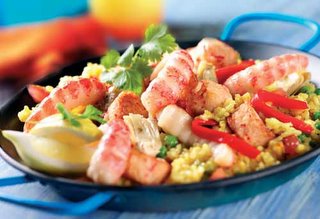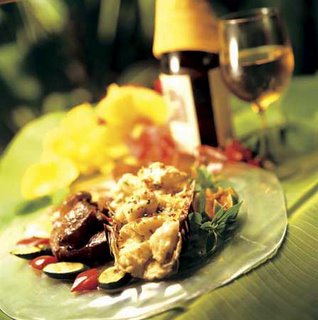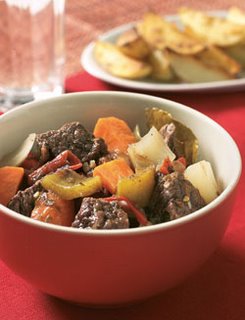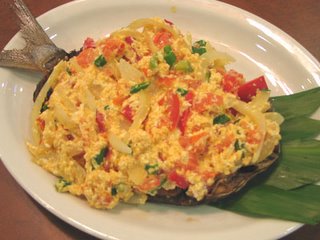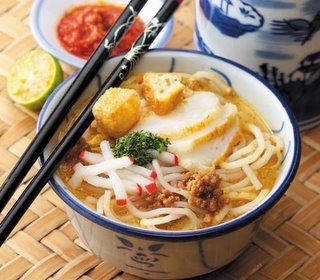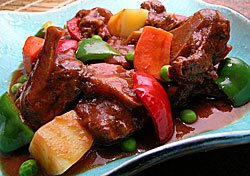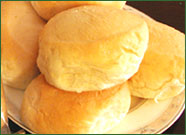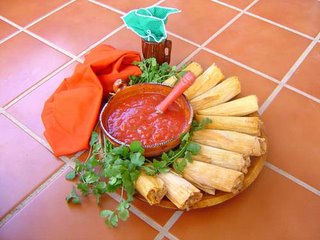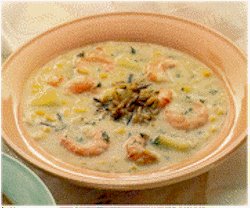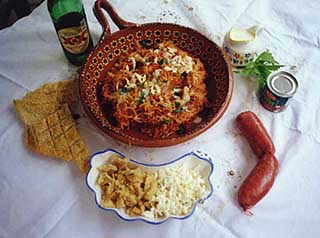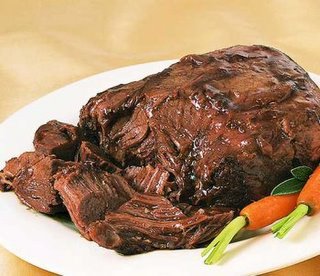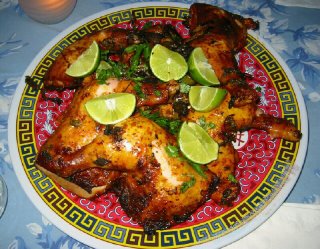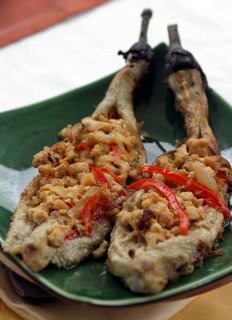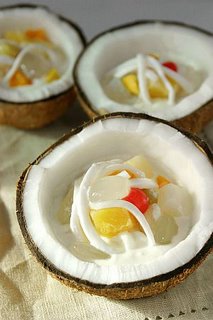 This Post Contains Lumpia (Fried) [2 styles], Lumpia Sauce, Lumpia Wrapper [2 styles], Lumpia Bangus, Lumpia Labong (Bamboo Shoot), Lumpia with Papaya, Lumpia with Peanuts, Lumpia with Ubod [2 styles]
This Post Contains Lumpia (Fried) [2 styles], Lumpia Sauce, Lumpia Wrapper [2 styles], Lumpia Bangus, Lumpia Labong (Bamboo Shoot), Lumpia with Papaya, Lumpia with Peanuts, Lumpia with Ubod [2 styles]Lumpia (Fried) Recipe - Style 1
Mix ½ kilo pork meat (ground), ½ kilo chopped shrimps, ¼ cup chopped apulid, ¼ cup mushrooms, ½ cup chopped onion, salt and pepper to taste, 3 egg yolks and toyo to taste. Steam until meat is cooked. Wrap in lumpia wrappers into very small rolls and fry in deep fat. Serve with sweet sour sauce.
SAUCE: Mix vinegar, water, sugar, and salt to produce a sweet-sour taste. Pour in a pan then add about one tablespoon catsup or tomato sauce. When boiling thicken the sauce with a little cornstarch dissolved in water. Add 1 small sliced hot pepper and a little chopped garlic.
Lumpia (Fried) Recipe - Style 2
½ cup chopped pork
1 cup chopped beef
½ cup chopped ham
½ cup boiled garbanzos or potatoes, cut into cubes
2 tomatoes (cut into pieces)
1 onion (minced)
½ laurel leaf
3 cloves garlic (pounded)
2 eggs (hard boiled and cut into pieces)
½ cup water
1 teaspoon pimenton
1 box raisins (small size)
Lumpia wrappers
Salt
Sauté garlic, onions, tomatoes. When light brown, add meat, laurel leaf, pimenton, and water. Add salt to taste. Cover and simmer until meat is tender. When nearly cooked, add garbanzos and raisins. Before wrapping let it cool. Add hard-boiled eggs and wrap in lumpia wrapper. Fold two ends well. Fry until golden brown. Serve with garlic, vinegar, pepper and salt.
Lumpia Sauce Recipe
Mix together
3 tablespoons cornstarch
1/3 cup brown sugar
¼ cup toyo sauce and
1-1/2 cups water. Strain if lumpy
1 head garlic
1 tbsp. Fat
Fry until brown, segments of macerated garlic. Remove the garlic. Into the heated fat pour slowly the sauce batter, stirring constantly until mixture thickens. Top with fried garlic.
Lumpia Wrapper Recipe - Style 1
2 cups flour
1 cup cold water
Mix the water and flour well. Work continuously with the hands in up and down motion until the gluten part of the flour will stick together into a mass and dough can be picked up at once. Grease very slightly a clean carajay. Drop a small ball of dough (in just a second) pressing it into a round sheet lightly and evenly over the deep part of the carajay, lift and pick very thin crust that sticks as it dries up.
CAUTION: Never make the heat of the fire too intense. Regulate it by using charcoal. Grease the carajay very slightly in the beginning, but avoid greasing it too often. When the wrapper is removed, scrape with a knife any remaining dough in the carajay, and wipe it with a clean cloth, used for the purpose. Trim neatly the edges of the wrapper.
Lumpia Wrapper Recipe - Style 2
1 cup flour
1 cup water
Mix flour and water and blend well to form a smooth batter.
Grease a clean griddle or frying pan very lightly. (Best way to do this is: use a piece of clean cloth or paper lightly moistened with oil and wipe surface of pan).
Using a paint brush, paint batter thinly over griddle or pan, working fast. Remove with pan cake turner as batter dries.
Lumpia (Bangus) Recipe
2 medium-sized bangus
1 small onion
1 small box raisins
Lard for frying
3 small tomatoes
1 tsp. Pounded garlic
25 lumpia wrappers
Salt and pepper to taste
Clean the fish and parboil. Remove the flesh from the bones and set aside. Cut tomatoes into small pieces and cut the onion length-wise. Sauté garlic, onion and tomatoes. Add bangus meat and raisins. Season with salt and pepper. Set aside and cool. Wrap by tablespoons in lumpia wrapper and fry in deep hot fat until golden brown. Drain in absorbent paper and serve hot with sweet sour sauce.
Lumpia Labong (Bamboo Shoot) Recipe
½ kilo pork
5 bean cakes (tokua)
1 big onion
6 cups labong (boiled)
½ kilo shrimps
3 teaspoons pimenton
6 cloves garlic
Salt and pepper to taste
Lumpia wrappers
1 tbsp. Lard
Fresh lettuce
Slice the pork, shrimps, into pieces. Save the juice from the heads and shells of the shrimps. Chop the labong. Sauté the garlic, onion and pimenton and add the meat and shrimp slices. Add the sliced and fried tokua then the shrimp juice.
Simmer a few minutes then add labong. Season to taste and cook until tender. Wrap in lumpia wrappers and lettuce and serve with sauce.
Lumpia with Papaya Recipe
3 cups green papaya, shredded to long, narrow pieces
½ cup pork, sliced to small pieces
¼ cup shrimps, sliced
2 segments garlic, chopped fine
Lumpia wrappers
2 tbsps. onion, sliced
2 tbsps. lard
¼ cup broth or shrimp extract
Salt and toyo to taste
Achuete coloring
Lettuce
Mash papaya with salt and squeeze dry after washing off salt.
Sauté garlic in 2 tablespoons lard; add onion, pork, and shrimps, and continue sautéing until meat is cooked. Stir in the shrimp extract. Boil. Add papaya and cook until papaya is tender. Add toyo and salt to taste and achuete coloring and mix well. Wrap in lumpia wrappers with lettuce just before serving, and serve with sauce.
Lumpia with Peanuts Recipe
¼ kilo pork, sliced
½ cup shrimps (shelled)
½ head small cabbage (cut fine)
1 small onion, sliced
3 cloves garlic, chopped fine
1 cup ground peanuts
2 tbsps. toyo (soy sauce)
1 small bundle kinchay
2 medium-sized carrots (diced)
2 medium-sized yellow camote (diced)
1 cup habichuelas (sliced
3 tbsps. lard
1 cup shrimp juice from pounded shells and heads of shrimps
2 squares tokua (diced)
Lumpia wrappers
Lettuce leaves
Extract the fat from the pork. Sauté garlic, onion and tokua. Add the pork, shrimp, then the shrimp juice. Simmer and then add habichuelas, carrots, cabbage, and yellow camote. Season with toyo and cook until done. Set aside in a platter to cool. Add the kinchay, sprinkle half of the amount of ground peanuts and wrap in individual wrappers with lettuce. Before closing each wrapper sprinkle about 1 teaspoon more of peanuts into each. Wrap and serve with lumpia sauce.
Lumpia with Ubod Recipe - Style 1
1 coconut ubod (heart
¼ kilo shrimps
½ kilo pork
1 teaspoon sugar
½ cup shrimp juice
Salt to taste
Lard
Lumpia wrappers
Lettuce
Boil the pork until tender. Extract the shrimp juice from the shrimp shells. Cut the coconut heart (ubod) into strips. Sauté the shrimp and pork and then add the shrimp juice. Boil. Add coconut heart. Simmer over low heat until the coconut heart is tender. Add the sugar and salt and cook a minute longer. Cool. Wrap in lumpia wrappers and lettuce.
Lumpia with Ubod Recipe - Style 2
½ cup shrimps
½ cup pork
1 cup shredded cabbage
¼ cup garbanzos
1 cake tokua
2 cloves garlic
½ tbsp. Sugar
Toyo and pepper to taste
1 cup ubod (coconut heart)
1 small onion
1 Spanish sausage
¼ cup ham
½ cup potatoes
½ cup lima beans
1 small carrot cut into strips
½ cup shrimp juice
Salt
Lumpia wrappers and lettuce
Blanch the shrimps, boil the pork until tender. Slice and cut the other ingredients, pound shrimp heads and mash in ½ cup pork broth. Strain liquid. Fry tokua until golden brown then add the pounded garlic, onion, shrimps, pork and the lima beans. Add meat shrimp liquid, sausage, toyo and ½ tablespoon sugar. When the lima beans are half done, add the potatoes, ham, carrot, ubod, cabbage, and garbanzos and let boil for five minutes. Season with salt and pepper. Let cool and wrap in lettuce and wrapper.
